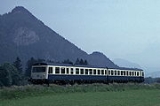
DB Class 628
Encyclopedia
The DB Class 628 is a twin-car, diesel multiple unit
operated by the Deutsche Bahn AG
for local passenger rail services.
Each coach rests on two twin-axle bogies. Only the bogie at the close-coupled end of the coach is driven. Power transmission from the motor is achieved using a Voith hydrodynamic transmission system with a converter (Wandler) and a T 311r coupling. Up to Class 628, a T 320 double-converter transmission was used. Motor and transmission are suspended elastically under the lightweight coach body. The operating brake is an automatic compressed air KE disc brake with automatic load braking and electronic anti-skid protection. In addition, for rapid braking, electromagnetic rail brakes are used; these can also be activated separately if required.
Coupled running enables up to four coupled pairs of coaches to be driven from one driver's cab. The control panel resembles that of the DB's standard driving consoles. Safety equipment includes the dead man's switch system, Sifa
, which is mandatory in Germany, as well as PZB 90
based on the I60R (Class 628.4) or I60 with ER24 recording device (Class 628.2) and train radio.
Class 628 units have proved to be reliable and economical in practice. Now that newer vehicles have appeared, though, passengers on the 628s will miss a number of refinements, especially air-conditioning, but also modern passenger information systems and easier, more accessible, disabled-friendly doors, because immediately behind the doors (one double or single door in the center and one single door next to each driver's position) there are two steps in order to reach low platforms. On some 628s, new passenger information systems with automatic announcements and displays for the next stop have been installed and in many regions ticket machines have also been fitted, as had been planned in the design.
Over the years the vehicles have not been completely free of technical problems, but the list of deficiencies is very short. For example, the coolant has a tendency to overheat on hot days if the radiators are not thoroughly cleaned. When traction conditions are poor, the 628 may not reach the speeds required by the timetable due to its low adhesive weight. Because the vehicles by today's standards are quite underpowered, its use on hilly routes results in long journey times. On newer vehicles such as the Class 641
, the Desiro (642), the Talent (643 and 644), the LINT (648)
or the Regio-Shuttle (650)
, which have partly replaced the 628s, two power cars have been used and the higher resultant costs accepted.
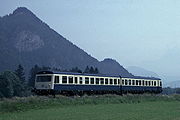 The development of the Class 628 began as far back as the early 1970s, when the Class 795 and 798
The development of the Class 628 began as far back as the early 1970s, when the Class 795 and 798
railbuses were reaching the end of their estimated useful life. The Bundesbahn's central office (Bundesbahn-Zentralamt) in Munich, in cooperation with the Waggonfabrik Uerdingen, began with the concept of a Class 628 local, passenger, multiple-unit, that were to replace the railbuses, the accumulator railcar
s of Class 515
. The new vehicles were also to be capable of being used on main lines, which required an increase in their top speed, stronger brake systems and greater comfort compared with the railbuses, but which were not to be more expensive to run than a railbus. In 1974, only 2 years later, Waggonfabrik Uerdingen and MaK
demonstrated the prototypes of the two-unit Class 628.0 and also a single-coach variant, the Class 627, for use on routes with lower numbers of passengers. The vehicles were tested and proved themselves exceptionally well, even though the lack of the power from the engines was already apparent on occasions. Initially it did not go into production, because for political reasons local passenger rail services were just being reorganised and it was not yet clear, which and how many vehicles would be needed. So the Class 628 project stalled for almost four years.
The following diesel motors are used on the Class 628.0 diesel multiple units:
MAN D 3256 BTXU
KHD V 12 L 413F
Transmission
Voith T 320r transmission systems are installed in these railcars. Experimentally some vehicles were fitted with an H-brake.
Technical data for the transmission:
The reversing gear is combined with the fluid drive and serves to change the direction or running. Reversing can be achieved during idling and also when the motor is switched off, but only when the vehicle is static and the drive has been emptied. It is activated with compressed air.
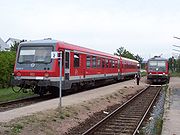 Before it became widespread, however, a number of short-term requirements from the future production Class 628.2 units were integrated, including a 1st class open compartment, better ventilation and a dividing wall between the driver's cab and the passenger compartment. Externally the front and back were more angled, the triple headlamp was moved down and a train destination display added in order to improve the vehicle's appearance and to keep passengers better informed. In all, 150 of these units were procured between 1986 and 1989. At the Kiel
Before it became widespread, however, a number of short-term requirements from the future production Class 628.2 units were integrated, including a 1st class open compartment, better ventilation and a dividing wall between the driver's cab and the passenger compartment. Externally the front and back were more angled, the triple headlamp was moved down and a train destination display added in order to improve the vehicle's appearance and to keep passengers better informed. In all, 150 of these units were procured between 1986 and 1989. At the Kiel
locomotive depot (Betriebswerk) several of these railcars were driver for a while at up to 140 km/h, but because this seriously increased wear and tear, these express duties were soon terminated again. The Class 628.2 with the DB's Regionalbahn
in Schleswig-Holstein
was given a redesign with new seats, new interior decor, wheelchair ramps etc. Several years before, a Karlsruhe 628.2 had also been given a fundamental modernisation of its interior.
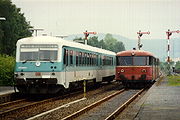
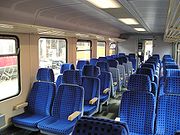 The second series was able to benefit from the everyday experience that had been gained in using the railcars. In 1992 Düwag
The second series was able to benefit from the everyday experience that had been gained in using the railcars. In 1992 Düwag
(formerly Waggonbau Uerdingen) proposed the Class 628.4 railcar, which once again had technical improvements and other refinements. The power of the diesel engine was increased by about 20% by using "charge cooling". The lower window panes on the doors were omitted as they had occasionally been broken on its predecessors, the Class 628.2, by flying stones. In order to install a double door at the close-coupled end of the two coaches in the multiple, they were both extended in length by about 50 cm each. Between November 1992 and Januar 1996 a total of 309 railcars were built, of which several were delivered to other railway companies, including those in Luxembourg
(see Operations) and Romania
.
The first vehicles in the regions of Rhein-Ruhr and the Southwest were given a modernisation of the interior. The railcars were matched to the current DB interior design. The seats have blue cushions and arm rests made of beech wood, the walls are silvery, the luggage section completely white, the windows are equipped with emergency hammers. The colour of the entrance area is white, and in some cases larger bicycle sections were installed in the centre of the carriage. On some of the units, the doors were also fitted with sensors.
A sixth set has been generated by motorising a driving coach. Two other 629s appeared in 2004 based on former 628.2s, that work with another 628.2 instead of a driving car.
Ulm Hauptbahnhof
has meanwhile stabled 2 power packs, that now have running numbers 628/629 340 (629 340 ex 628 341) and 628/629 344 (629 344 ex 628 349). Since 8 August 2008 Regio Südwest also has a power pack 628 301/629 301 (629 301 ex 628 257), which should follow the other two.
 Because in the early 1990s hardly any other railcars were available, several private railways also bought railcars of this type. In 1993/94 Eisenbahnen und Verkehrsbetriebe Elbe-Weser
Because in the early 1990s hardly any other railcars were available, several private railways also bought railcars of this type. In 1993/94 Eisenbahnen und Verkehrsbetriebe Elbe-Weser
(EVB) took delivery of five 628.4/928.4 sets, in 1994 Frankfurt-Königsteiner Eisenbahn (FKE) bought one 628.4/928.4 and, in 1995, two 628.9/629s. In 1995 Westerwaldbahn GmbH took over the Daadetalbahn line with one DB 628.4/928.4 (628 677); it added a 628.4 from FKE in 2008.
) in Kempten im Allgäu
. From there they were deployed to all the lines in the Allgäu
region until the end of 2002. From 2003 they reduced their radius of action to the Ausserfernbahn, and in January 2005 the last vehicle of this class (628 008/018) was finally withdrawn. Several have already been scrapped, others sold to Poland
, where they have been repainted and were placed in service again in the winter of 2005/2006 for the Koleje Mazowieckie
.
from the outset. From here they were used until 8 December 2007 in regular services on the Ausserfernbahn and on the Illertalbahn. Until the timetable change in 2006 they also ran to other destinations in the Allgäu
, e.g. on the line from Augsburg
to Füssen
.
At their last general inspection in 2001/2002 the vehicles underwent a number of modifications in order to standardise them with the sub-class 628.2. In early 2008 all 628.1s were withdrawn and, in that year, they were transferred to Hamm.
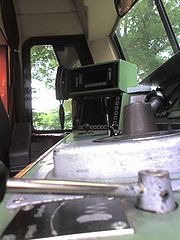 Multiple units of sub-classes 628.2 and .4 are used across virtually the whole of Germany, on main lines as well as branch lines.
Multiple units of sub-classes 628.2 and .4 are used across virtually the whole of Germany, on main lines as well as branch lines.
Currently multiples comprising two, coupled, Class 628 power cars work the Worms–Alzey–Bingen route as well as lines in the area around Ulm and which are thus different from the 628.9/629 compositions on the Mainz–Alzey line. In particular they can be told by the lack of a 1st class compartment and the two toilets in the centre of the train. There are also no folding seats as found in the driving cars or in the 629.
The Luxembourg State Railways, CFL
, owns two 628.4/928.4, which are numbered as per the DB system (628 505-0/928 505-7 und 628 506-8/928 506-5). These are identical with their counterparts in the DB apart from the company logo at the front: initially painted in peppermint green and white, but since 2001 in red livery. They ply between Trier and Luxembourg (as do German 628s; on this route mostly in double traction together) as well as providing passenger services within Luxembourg itself.
Diesel multiple unit
A diesel multiple unit or DMU is a multiple unit train consisting of multiple carriages powered by one or more on-board diesel engines. They may also be referred to as a railcar or railmotor, depending on country.-Design:...
operated by the Deutsche Bahn AG
Deutsche Bahn
Deutsche Bahn AG is the German national railway company, a private joint stock company . Headquartered in Berlin, it came into existence in 1994 as the successor to the former state railways of Germany, the Deutsche Bundesbahn of West Germany and the Deutsche Reichsbahn of East Germany...
for local passenger rail services.
Design
(The following description is primarily related to the Class 628.4, but is largely valid for the other variants as well)Each coach rests on two twin-axle bogies. Only the bogie at the close-coupled end of the coach is driven. Power transmission from the motor is achieved using a Voith hydrodynamic transmission system with a converter (Wandler) and a T 311r coupling. Up to Class 628, a T 320 double-converter transmission was used. Motor and transmission are suspended elastically under the lightweight coach body. The operating brake is an automatic compressed air KE disc brake with automatic load braking and electronic anti-skid protection. In addition, for rapid braking, electromagnetic rail brakes are used; these can also be activated separately if required.
Coupled running enables up to four coupled pairs of coaches to be driven from one driver's cab. The control panel resembles that of the DB's standard driving consoles. Safety equipment includes the dead man's switch system, Sifa
Sifa
Sifa or the deadman's control system is a safety device in a train intended to bring the train automatically to a stop if the driver becomes incapacitated.-Description:...
, which is mandatory in Germany, as well as PZB 90
Punktförmige Zugbeeinflussung
PZB or Indusi is an intermittent cab signalling system and train protection system used in Germany, Austria, Slovenia, Croatia, Romania, Israel and on one line in Canada....
based on the I60R (Class 628.4) or I60 with ER24 recording device (Class 628.2) and train radio.
Class 628 units have proved to be reliable and economical in practice. Now that newer vehicles have appeared, though, passengers on the 628s will miss a number of refinements, especially air-conditioning, but also modern passenger information systems and easier, more accessible, disabled-friendly doors, because immediately behind the doors (one double or single door in the center and one single door next to each driver's position) there are two steps in order to reach low platforms. On some 628s, new passenger information systems with automatic announcements and displays for the next stop have been installed and in many regions ticket machines have also been fitted, as had been planned in the design.
Over the years the vehicles have not been completely free of technical problems, but the list of deficiencies is very short. For example, the coolant has a tendency to overheat on hot days if the radiators are not thoroughly cleaned. When traction conditions are poor, the 628 may not reach the speeds required by the timetable due to its low adhesive weight. Because the vehicles by today's standards are quite underpowered, its use on hilly routes results in long journey times. On newer vehicles such as the Class 641
DBAG Class 641
The DBAG Class 641 is a class of German railway vehicle operated by Deutsche Bahn AG . They are diesel railcars belonging to the Alstom Coradia A TER family. Their development started as a joint project between DBAG and the French national railway, SNCF, on the one hand, and the railway vehicle...
, the Desiro (642), the Talent (643 and 644), the LINT (648)
Alstom LHB Coradia LINT
The Alstom Coradia LINT is a diesel single-unit or two-unit articulated passenger railcar manufactured by Alstom. The acronym LINT is short for the German "Leichter Innovativer Nahverkehrstriebwagen"...
or the Regio-Shuttle (650)
Stadler Regio-Shuttle RS1
The Stadler Regio-Shuttle RS1 is the first widely-used, new generation, diesel railcar in Germany for local railway services. Its most characteristic feature is the trapezium-shaped window frames...
, which have partly replaced the 628s, two power cars have been used and the higher resultant costs accepted.
Class 628.0

Uerdingen railbus
The Uerdingen railbus is the common term for the multiple units which were developed by the German firm of Waggonfabrik Uerdingen for the Deutsche Bundesbahn and private railways after the Second World War. These vehicles were diesel-powered, twin-axle railbuses of light construction...
railbuses were reaching the end of their estimated useful life. The Bundesbahn's central office (Bundesbahn-Zentralamt) in Munich, in cooperation with the Waggonfabrik Uerdingen, began with the concept of a Class 628 local, passenger, multiple-unit, that were to replace the railbuses, the accumulator railcar
Accumulator railcar
An accumulator railcar is an electrically driven railcar whose energy is derived from rechargeable batteries that drive its traction motors.The main advantage of these vehicles is their clean, quiet operation...
s of Class 515
DB Class ETA 150
The accumulator cars of Class ETA 150 were German railbuses used extensively by the Deutsche Bundesbahn over 40 years. The driving cars were very comfortable to travel in because they were quiet , rode well on the rails due to the weight of the batteries and were pollution-free...
. The new vehicles were also to be capable of being used on main lines, which required an increase in their top speed, stronger brake systems and greater comfort compared with the railbuses, but which were not to be more expensive to run than a railbus. In 1974, only 2 years later, Waggonfabrik Uerdingen and MaK
Maschinenbau Kiel
Maschinenbau Kiel GmbH designed, manufactured and marketed marine diesel engines, diesel locomotives and tracked vehicles under the MaK brand name. The three primary operating divisions of Maschinenbau Kiel GmbH were sold to different companies in the 1990s.Rheinmetall acquired the military...
demonstrated the prototypes of the two-unit Class 628.0 and also a single-coach variant, the Class 627, for use on routes with lower numbers of passengers. The vehicles were tested and proved themselves exceptionally well, even though the lack of the power from the engines was already apparent on occasions. Initially it did not go into production, because for political reasons local passenger rail services were just being reorganised and it was not yet clear, which and how many vehicles would be needed. So the Class 628 project stalled for almost four years.
Design and technical data
MotorThe following diesel motors are used on the Class 628.0 diesel multiple units:
MAN D 3256 BTXU
- Installed in Class 628.0 (628 001/011 to 628 005/015)
- Type: Four stroke diesel motor with turbocharging and water cooling
- Layout: 6 cylinder in-line motor (horizontal)
- Usable power: 210 kW (285 PS)
- Rpm: 2,100 rpm
- Stroke/Bore: 150 mm / 132 mm
- Total weight: 1,160 kg
KHD V 12 L 413F
- Installed in Class 628.0 (628 006/016 to 628 010/020, on 628 006 to 008 other motors now fitted)
- Type: Four stroke diesel motor with air cooling
- Layout: V 12 engine, 90°
- Usable power: 206 kW (280 PS)
- Rpm: 2,100 rpm
- Stroke/Bore: 130 mm / 125 mm
- Total weigh: 1,220 kg
Transmission
Voith T 320r transmission systems are installed in these railcars. Experimentally some vehicles were fitted with an H-brake.
Technical data for the transmission:
- Two hydraulic fluid drives
- Reversing with electro-pneumatic actuation
- Primary influence by primary control and lubricatiing pump pressure
- Transferable power: Class 628.0 = 202 kW (275 PS) at 2,100 rpm
The reversing gear is combined with the fluid drive and serves to change the direction or running. Reversing can be achieved during idling and also when the motor is switched off, but only when the vehicle is static and the drive has been emptied. It is activated with compressed air.
Class 628.1/928.1
Behind the scenes, engineers continued to develop the railcar apace. In 1981 they demonstrated the Class 628.1. The most important difference was that the second power car was dropped, because the remaining one was strong enough to move the coupled pair. The second unit could therefore be used as a driving car (designated the Class 928.1). Together with a few other changes, such as a simplified electrical system, the omission of one of the two toilets and one of the four entrances each side, and the installation of equipment to enable one-man operation, the new variant was even more economical. In addition there was a single-coach version again, the Class 627.1, of which 5 prototypes were procured. The new vehicles were tested for two years and, like their predecessors, proved to be outstanding, so that nothing stood in the way as the two-car version went into production. The single-unit variant did not, however, as it had only a few more seats than a bus and could not be deployed economically. Coach number 628 102 is unusual in being the only one of this small batch with a 1st class compartment.Class 628.2/928.2

Kiel
Kiel is the capital and most populous city in the northern German state of Schleswig-Holstein, with a population of 238,049 .Kiel is approximately north of Hamburg. Due to its geographic location in the north of Germany, the southeast of the Jutland peninsula, and the southwestern shore of the...
locomotive depot (Betriebswerk) several of these railcars were driver for a while at up to 140 km/h, but because this seriously increased wear and tear, these express duties were soon terminated again. The Class 628.2 with the DB's Regionalbahn
RegionalBahn
The Regionalbahn is a type of local passenger train in Germany.-Service:Regionalbahn trains usually call at all stations on a given line, with the exception of RB trains within S-Bahn networks, these may only call at selected stations...
in Schleswig-Holstein
Schleswig-Holstein
Schleswig-Holstein is the northernmost of the sixteen states of Germany, comprising most of the historical duchy of Holstein and the southern part of the former Duchy of Schleswig...
was given a redesign with new seats, new interior decor, wheelchair ramps etc. Several years before, a Karlsruhe 628.2 had also been given a fundamental modernisation of its interior.
Class 628.4/928.4


DUEWAG
The DUEWAG AG was one of Germany's major manufacturers for rail vehicles. The business was sold in 1999 to Siemens transportation.- History :The company was founded in 1898 as Waggonfabrik Uerdingen AG in Uerdingen...
(formerly Waggonbau Uerdingen) proposed the Class 628.4 railcar, which once again had technical improvements and other refinements. The power of the diesel engine was increased by about 20% by using "charge cooling". The lower window panes on the doors were omitted as they had occasionally been broken on its predecessors, the Class 628.2, by flying stones. In order to install a double door at the close-coupled end of the two coaches in the multiple, they were both extended in length by about 50 cm each. Between November 1992 and Januar 1996 a total of 309 railcars were built, of which several were delivered to other railway companies, including those in Luxembourg
Luxembourg
Luxembourg , officially the Grand Duchy of Luxembourg , is a landlocked country in western Europe, bordered by Belgium, France, and Germany. It has two principal regions: the Oesling in the North as part of the Ardennes massif, and the Gutland in the south...
(see Operations) and Romania
Romania
Romania is a country located at the crossroads of Central and Southeastern Europe, on the Lower Danube, within and outside the Carpathian arch, bordering on the Black Sea...
.
The first vehicles in the regions of Rhein-Ruhr and the Southwest were given a modernisation of the interior. The railcars were matched to the current DB interior design. The seats have blue cushions and arm rests made of beech wood, the walls are silvery, the luggage section completely white, the windows are equipped with emergency hammers. The colour of the entrance area is white, and in some cases larger bicycle sections were installed in the centre of the carriage. On some of the units, the doors were also fitted with sensors.
Class 628.9/629
A special variant, based on the Class 628.4, was procured for duties on the hilly Alzey–Mainz railway. Five multiples were bought, both coaches in each pair being motorised. These trains were designated as Class 628.9/629, but apart from having two power cars were identical with the Class 628.4. Due to its higher maintenance and operating costs there is no likelihood of the 628.9/629s being procured for use on lines which are predominantly level. The 628.9/629s do not need double the fuel of a 628, because the two power cars have shorter periods under load.A sixth set has been generated by motorising a driving coach. Two other 629s appeared in 2004 based on former 628.2s, that work with another 628.2 instead of a driving car.
Ulm Hauptbahnhof
Ulm Hauptbahnhof
is the Hauptbahnhof or central railway station for the city of Ulm, which lies on the Danube, on the border of the German states of Baden-Württemberg and Bavaria. It is on ICE line from Stuttgart to Munich and the Paris –Budapest Magistrale for Europe line that is supported by the European Union...
has meanwhile stabled 2 power packs, that now have running numbers 628/629 340 (629 340 ex 628 341) and 628/629 344 (629 344 ex 628 349). Since 8 August 2008 Regio Südwest also has a power pack 628 301/629 301 (629 301 ex 628 257), which should follow the other two.
Private railways

Eisenbahnen und Verkehrsbetriebe Elbe-Weser
EVB Eisenbahnen und Verkehrsbetriebe Elbe-Weser GmbH is a German railway and bus company offering passenger and freight services that is headquartered in Zeven and Bremervörde...
(EVB) took delivery of five 628.4/928.4 sets, in 1994 Frankfurt-Königsteiner Eisenbahn (FKE) bought one 628.4/928.4 and, in 1995, two 628.9/629s. In 1995 Westerwaldbahn GmbH took over the Daadetalbahn line with one DB 628.4/928.4 (628 677); it added a 628.4 from FKE in 2008.
Class 628.0
All the Class 628.0 prototype vehicles were finally homed at the depot (BahnbetriebswerkBahnbetriebswerk
A Bahnbetriebswerk is the equivalent of a locomotive depot on the German and Austrian railways. It is an installation that carries out the maintenance, minor repairs, refuelling and cleaning of locomotives and other motive power. In addition it organises the deployment of locomotives and crews...
) in Kempten im Allgäu
Kempten im Allgäu
Kempten is the largest town in Allgäu, a region in the south-west of Bavaria, Germany. The population was ca 61,000 in 2006. The area was possibly settled originally by Celts, but was later overtaken by the Romans, who called the town Cambodunum...
. From there they were deployed to all the lines in the Allgäu
Allgäu
The Allgäu is a southern German region in Swabia. It covers the south of Bavarian Swabia and southeastern Baden-Württemberg. The region stretches from the prealpine lands up to the Alps...
region until the end of 2002. From 2003 they reduced their radius of action to the Ausserfernbahn, and in January 2005 the last vehicle of this class (628 008/018) was finally withdrawn. Several have already been scrapped, others sold to Poland
Poland
Poland , officially the Republic of Poland , is a country in Central Europe bordered by Germany to the west; the Czech Republic and Slovakia to the south; Ukraine, Belarus and Lithuania to the east; and the Baltic Sea and Kaliningrad Oblast, a Russian exclave, to the north...
, where they have been repainted and were placed in service again in the winter of 2005/2006 for the Koleje Mazowieckie
Koleje Mazowieckie
Koleje Mazowieckie is a regional rail operator in the Masovian Voivodeship of Poland.- History :The company was founded in 2004 as a joint venture of the Masovian Voivodeship, with 51% shares, and the, then government-owned, PKP Przewozy Regionalne, with 49% shares, to handle local passenger...
.
Class 628.1
The three multiples of the transitional class, 628.1 (628 / 928 101, 102 and 103), were all stabled at Kempten im AllgäuKempten im Allgäu
Kempten is the largest town in Allgäu, a region in the south-west of Bavaria, Germany. The population was ca 61,000 in 2006. The area was possibly settled originally by Celts, but was later overtaken by the Romans, who called the town Cambodunum...
from the outset. From here they were used until 8 December 2007 in regular services on the Ausserfernbahn and on the Illertalbahn. Until the timetable change in 2006 they also ran to other destinations in the Allgäu
Allgäu
The Allgäu is a southern German region in Swabia. It covers the south of Bavarian Swabia and southeastern Baden-Württemberg. The region stretches from the prealpine lands up to the Alps...
, e.g. on the line from Augsburg
Augsburg
Augsburg is a city in the south-west of Bavaria, Germany. It is a university town and home of the Regierungsbezirk Schwaben and the Bezirk Schwaben. Augsburg is an urban district and home to the institutions of the Landkreis Augsburg. It is, as of 2008, the third-largest city in Bavaria with a...
to Füssen
Füssen
Füssen is a town in Bavaria, Germany, in the district of Ostallgäu situated from the Austrian border. It is located on the banks of the Lech river. The River Lech flows into the Forggensee...
.
At their last general inspection in 2001/2002 the vehicles underwent a number of modifications in order to standardise them with the sub-class 628.2. In early 2008 all 628.1s were withdrawn and, in that year, they were transferred to Hamm.
Class 628.2/.4

Currently multiples comprising two, coupled, Class 628 power cars work the Worms–Alzey–Bingen route as well as lines in the area around Ulm and which are thus different from the 628.9/629 compositions on the Mainz–Alzey line. In particular they can be told by the lack of a 1st class compartment and the two toilets in the centre of the train. There are also no folding seats as found in the driving cars or in the 629.
The Luxembourg State Railways, CFL
Chemins de Fer Luxembourgeois
Société Nationale des Chemins de Fer Luxembourgeois is the national railway company of Luxembourg. In 2005, the company carried approximately 14.1 million passengers and 11.7 million tonnes of goods...
, owns two 628.4/928.4, which are numbered as per the DB system (628 505-0/928 505-7 und 628 506-8/928 506-5). These are identical with their counterparts in the DB apart from the company logo at the front: initially painted in peppermint green and white, but since 2001 in red livery. They ply between Trier and Luxembourg (as do German 628s; on this route mostly in double traction together) as well as providing passenger services within Luxembourg itself.
Services
Class 628.2 and 628.4 are used on the following services in the different regions (2011):Baden-Württemberg
- RB Miltenberg – Seckach
- RB Öhringen – Schwäbisch Hall-Hessental
- RB Wertheim – Crailsheim
- RB Weinheim (Bergstraße) – Fürth (Odenwald)
- RB Bruchsal – Germersheim
- RB Ehingen (Donau) – Ulm – Memmingen
- RB Ulm Hbf – Aalen (- Ellwangen/Crailsheim)
Bayern
- RB Hof Hbf – Münchberg – Neuenmarkt-Wirsberg
- RB Hof Hbf – Bad Steben
- RB Hof Hbf – Selb Stadt
- RB Münchberg – Helmbrechts
- RB Neuenmarkt-Wirsberg – Lichtenfels
- RB Coburg – Bad Rodach
- RB Marktredwitz – Kirchenlaibach – Bayreuth Hbf
- RB Weiden (Oberpf) – Kirchenlaibach – Bayreuth Hbf
- RB Bayreuth Hbf – Kulmbach
- RB Bayreuth Hbf – Pegnitz
- RE Aschaffenburg – Wertheim
- RB Miltenberg – Seckach
- RB Bogen – Neufahrn (Niederbayern)
- RB Mühldorf – Burghausen
- RB Mühldorf – Landshut
- RB Mühldorf – Rosenheim
- RB Mühldorf – Freilassing (- Salzburg)
- RB Mühldorf – Simbach am Inn
- RB Mühldorf – Passau
- RB Traunstein – Waging
- RB Wasserburg – Ebersberg
- RB Mühldorf – Traunstein
Brandenburg
- RB66 Angermünde – Stettin
- RE5800 (Belzig –) Berlin – Stettin
- RE5801 Stettin – Berlin (– Potsdam)
- RE Berlin Gesundbrunnen – Eberswalde Hbf
Hessen
- RB25 Limburg (Lahn) – Gießen
- RB34 Bad Vilbel – Glauburg-Stockheim
- RB35/RE35 Fulda – Gießen
- RB42 Marburg (Lahn) – Frankenberg (Eder)
- RB43 Marburg (Lahn) – Erndtebrück
- RB52 Fulda – Gersfeld (Rhön)
- RB61 (Frankfurt (Main) –) Dreieich-Buchschlag – Dieburg
- RB63 Worms – Bensheim
- RB69 Weinheim (Bergstraße) – Fürth (Odenwald)
Niedersachsen
- RB Uelzen – Wittingen – Gifhorn – Braunschweig
- RB Bremen – Langwedel (Weser) – Soltau – Uelzen
- EVB Buxtehude – Bremervörde – Bremerhaven
- RB Buchholz – Soltau – Walsrode – Bennemühlen (– Hannover )
- RB Rotenburg – Verden
- EVB Cuxhaven – Dorum – Bremerhaven
- RB Braunschweig – Wolfenbüttel – Schöppenstedt
- RB Salzgitter-Lebenstedt – Braunschweig
- RB Braunschweig – Wolfenbüttel – Vienenburg – Bad Harzburg/Goslar
- RB Braunschweig – Wolfenbüttel – Vienenburg – Goslar
Nordrhein-Westfalen
- RE12 Köln Hbf - Euskirchen – Gerolstein – Trier
- RE17 Hagen – Schwerte – Bestwig – Brilon Wald – Warburg / Willingen
- RB32 Wesel - Bocholt
- RB37 Duisburg Hbf - Duisburg-Entenfang
- RB38 Köln Hbf - Düsseldorf Hbf
- RB47 Solingen – Remscheid – Wuppertal
- RB55 Brilon Wald – Willingen – Korbach
- RB94 Erndtebrück – Bad Laasphe – Marburg
Rheinland-Pfalz and Saarland
- RE12 Köln Hbf - Euskirchen – Gerolstein – Trier
- RE13 Mainz – Alzey
- RE14/RB14 Luxembourg – Wasserbillig – Trier (–Schweich)
- RB25 Koblenz – Limburg
- RB31 Mainz – Alzey
- RB33 Mainz – Bad Kreuznach – Türkismühle
- RB35 Worms – Alzey – Bingen (Rhein) Stadt
- RB44 Mannheim-Friedrichsfeld – Mannheim – Ludwigshafen – Worms – Mainz
- RB45 Neustadt – Bad Dürkheim – Feinsheim – Grünstadt – Monsheim
- RB46 Frankenthal – Freinsheim – Grünstadt – Ramsen (– Eiswoog)
- RB49 Wörth (Rhein) / Kaiserslautern – Schifferstadt – Ludwigshafen Hbf – Ludwigshafen BASF
- RB59 Germersheim – Philippsburg – Graben-Neudorf – Bruchsal
- RB63 Worms – Bensheim
- RB72 Lebach – Illingen – Saarbrücken
- RB77 Niedaltdorf – Dillingen
- RB83 Gerolstein – Trier
- RB92 Andernach – Mayen – Kaisersesch
- RB94 Bullay – Traben-Trarbach
- RB97 Betzdorf – Daaden
Schleswig-Holstein
Just 628 685 is here and is used on Flensburg–Eckernförde and Kiel–Neumünster services.Sources
- Deutsche Bundesbahn: DV 987/323: Bedienungsanleitung für die Dieseltriebwagen 627.0 und 628.0.
- Andreas M. Räntzsch: Baureihe 627/628. - Stuttgart, Transpress, 2003. - ISBN 3-613-71202-4, S. 41-44.
- Michael Gröbner: Baureihe 628.4. Im Führerstand. In: LOK MAGAZIN. Nr. 251/Jahrgang 41/2002. GeraNova Zeitschriftenverlag GmbH München, , S. 50-52.
External links
- Railcar Lexicon
- BR 628 in Luxembourg
- There is a relevant English-language forum at Railways of Germany

